Bohemia’s Antipodes: Post-Communist Czech Migration to New Zealand
-
Author(s):Opara, OksanaPublished in:Central and Eastern European Migration Review, Vol. 7, No. 2, 2018, pp. 5-34DOI: 10.17467/ceemr.2018.10Received:
23 October 2017
Accepted:13 September 2018
Published:3 December 2018
Views: 23163
In the post-communist era, the European migration space changed significantly. It has become characterised predominantly by temporary labour migration and new forms of circular, return and onward migration which are collectively theorised as ‘liquid’. The 2004/2007 eastward expansion of the EU resulted in the re-emergence of large-scale East-West intra-EU migration; however, Czechia continues to have one of the lowest levels of emigration among EU member-states in Central and Eastern Europe (CEE). This article analyses Czech migration to New Zealand, which constitutes a considerable portion of overall Czech emigration. It is hypothesised that this flow can be understood as an example of ‘liquid’ migration beyond the EU to a distant settler society. Data from Immigration New Zealand and Stats NZ are examined to identify the trends, patterns and sociodemographic profile of Czech-to-New Zealand migration; other secondary sources provide a preliminary sketch of the motivations behind (and lived experiences of) Czech migrants in New Zealand. The study finds that this migration is increasing – mostly for temporary work, holidaying or visiting friends and relatives – and one of the largest, youngest and most recently arrived migrant groups from the CEE EU-10 countries. It is concluded that Czechia’s comparatively high standard of living may be an explanatory factor behind the relatively large flow of its people to New Zealand and that further qualitative investigation is needed to elucidate the motivations and diverse experiences of individual Czech migrants. The article ultimately contributes to comparative migration studies by exploring a potentially unique case of liquid migration to a traditional settler society.
Introduction
Countries of Central and Eastern Europe (CEE) have had an important impact on broader European migration flows since at least the early 1990s, when major political and socioeconomic changes transformed the region, including the nature of its human mobility. Scholarly discourse and theoretical approaches have accordingly responded to these changes. Most migration literature on this topic has focused on intra-EU migration or the movement of EU nationals to major destinations like the United States and the United Kingdom but CEE migration to newer, under-studied destinations can still reward our critical attention.
One of these under-studied CEE migration flows has been from the Czech Republic (henceforth Czechia) to New Zealand, which was chosen as the focus of this study because there is a relatively large number of educated and skilled young adult Czech nationals moving to New Zealand on both a temporary and a permanent basis. The Czech Ministry of Foreign Affairs recognises that New Zealand has, since the 1990s, ‘become a popular destination for emigrants’, including skilled individuals, while also noting the importance of the United Kingdom and Ireland, Australia (as a destination for Czech students) and the United States (as a hub of both legal and illegal labour opportunities) (Czech Ministry of Foreign Affairs 2010). According to the OECD (2017: 180), 3 900 Czechs reportedly emigrated in 2015 and New Zealand migration statistics data suggest that almost one fifth (18 per cent) of those emigrants went to New Zealand: 694 Czechs were recorded as arriving to New Zealand in the same year, intending to stay for at least 12 months. This is despite research showing that Czechia has not been a ‘significant emigration country’ (Drbohlav, Lachmanová-Medová, Čermák, Janská, Čermáková and Dzúrová 2009: 21) since 1989 and while the 2004 eastward enlargement of the EU spurred significant East-West migration – mainly from Poland, Romania and Bulgaria – there has been ‘no significant rise in emigration’ from Czechia (Fassman, Kohlbacher and Reeger 2014: 44). The relatively high rate of Czechia-New Zealand migration indeed warrants scholarly investigation, considering that Czech nationals have, overall, remarkably low intentions of moving abroad compared with other CEE countries (Di Cara 2016; European Commission 2010). Górny (2017) has emphasised that the role of non-EU emigration destinations has diminished for CEE EU countries such as Czechia and that emigration from there will continue to take place mainly within the Union in documented, long-term form. However, this article hypothesises that the new ‘liquid’ form of post-EU-accession migration in the twenty-first century – which is typically temporary, labour-driven and unpredictable – extends globally to important non-EU destinations (as discussed by Black, Engbersen, Okólski and Panţîru 2010: 43), for which the steadily increasing migration of Czechs to New Zealand is an insightful case study.
The article begins by overviewing Europe’s changing migration landscape over the last four decades and introducing the theoretical approaches that have been developed in response, with emphasis on research by Engbersen and Snel (2013), King (2018) and others around the concept of ‘liquid’ migration. New Zealand’s immigration policy framework is then discussed, including post-1986 legislative changes that altered the type and composition of migration to New Zealand. Post-communist migration from Czechia to New Zealand is subsequently described and analysed comparatively in relation to other CEE-New Zealand flows, using migration statistics collected by Stats NZ, data on visa and permits approval from Immigration New Zealand and census data. New Zealand media sources are also considered to provide a preliminary sketch of the motivations behind, and lived experiences of, Czech migrants in New Zealand, in lieu of richer qualitative investigation. The article ultimately seeks to highlight the potentially unique case of Czech migration to New Zealand and to offer some theoretical insights for the study of Central and Eastern European migrants’ movement to non-EU destinations in general, which may support future qualitative research on their experiences of temporary labour migration and settlement in New Zealand as well as other traditional settler countries such as the United States, Canada and Australia.
Historical and theoretical background
The fall of the Berlin Wall marked the end of the Cold War, which had dramatic consequences for CEE countries in all spheres of life. Many political, institutional and economic reforms were implemented and citizens regained the freedom to travel internationally after more than four decades of isolation behind the Iron Curtain. Western Europeans tended to meet this new freedom of travel with anxiety: public opinion and some politicians showed concern about potential mass migration from the East flooding into the ‘old’ Europe. However, these fears have not materialised and the strongly anticipated East-West exodus did not occur during the 1990s (Okólski 2012; Wallace 2002).
Instead, since the 1990s, migration has become more globalised, accelerated in growth, diversified in its flows (King 2018: 1; Vertovec 2007). The migration regimes and systems of CEE countries have accordingly transformed: from transition destinations of illegal migration to the West to forming a ‘buffer’ zone at the gates of ‘Fortress Europe’ (Drbohlav 2012; Drbohlav and Janská 2009). By the turn of the new millennium, economic and social polarisation within CEE produced new intra-regional movements. Czechia became a country predominantly of immigration along with several other CEE countries such as Hungary (and much more recently, Poland) owing in part to its relatively high demand for foreign labour and relatively high standards of living, political stability and democratic development – not to mention its cultural and linguistic proximity to and shared socialist history with nearby countries (Drbohlav et al. 2009; Okólski 2012; Wallace 2002; Wallace and Palyanitsa 1995). Reflecting these changes, a 1998 survey (IOM cited in Wallace 2002: 605) of CEE nationals’ migration intentions by the International Organisation for Migration indicated that about half of Czech respondents were interested in temporary labour migration; however, only 11 per cent of Czechs reported wanting to emigrate permanently. According to the 2005 Eurobarometer survey (European Foundation of the Improvement of Living and Working Conditions 2006 cited in Duszczyk and Matuszczyk 2014: 25), just 1.2 per cent of Czech respondents expected to move to another EU country in the following five years, the lowest level of migration intentions out of the 8 CEE countries that joined the EU in 2004 – although, in 2012, 94 per cent of Czech respondents were aware ‘that they had the right to migrate and live freely in another EU member state’ (Duszczyk and Matuszczyk 2014: 25). The situation has remained largely similar since the eastward enlargement of the EU in 2004, which saw 10 countries, including Czechia, Poland and Hungary, accessioned into the union. OECD data indicate that Czechia has the lowest number of nationals emigrating to other EU destinations than any other CEE EU-10 country (OECD 2007).
This new chapter in the history of intra-EU migration has spurred new forms of short-term and non-linear types of temporary labour migration (Black et al. 2010; Glorius, Grabowska-Lusińska and Kuvik 2013; Okólski 2007; Triandafyllidou 2013). Engbersen and Snel (2013) theorise these new forms of migration collectively as ‘liquid’. The metaphorical term builds on Bauman’s study Liquid Modernity (2000), which proposes that, in the globalised era of the twenty-first century, the ‘erstwhile “solidity” of fixed notions such as social class, stable families, cohesive neighbourhoods, and the nation-state has been replaced by societies which are, in many respects, fluid, flexible, and under constant change’ (King 2018: 5). In this context, migration is no longer primarily comprised of one-way flows from sending to receiving countries, where the final sign of success is assimilation with the host society and returning home or attempting to re-settle elsewhere is regarded as failure (Goździak and Pawlak 2016). Owing to the increased global demand for skilled and temporary labour and increasingly affordable global travel and communication, migrants engage in more flexible forms of movement that are often temporary and characterised by a ‘deliberate stance of keeping options open’ (King 2018: 6).
Liquid migration tends to be motivated by migrants’ labour needs rather than family obligations, reflecting people’s increasing tendency to raise children and marry later in life (Engbersen and Snel 2013: 34). Some migrants may only stay abroad to work for short periods, move ‘to several different countries in short successions’, or adapt to Europe’s fluctuating labour markets by alternating circularly between their home country and diverse destinations, which in some cases resembles ‘transnational commuting’ (Goździak and Pawlak 2016: 109) or ‘incomplete migration’ (Okólski 2001). A consequence of these diverse flows is that the concept of temporary ‘anchoring’ becomes an important means of capturing the essence of migrants’ ‘drifting lives’, ‘complex identities’ and ‘mechanisms of settling down in terms of searching for relative stability rather than putting down roots’ (Grzymała-Kazłowska and Brzozowska 2017: 1; see also Grzymała-Kazłowska 2017). Migrants can also continue to work temporarily in other destinations (onward migration) and experience ‘multiple returns’ home to such an extent that national borders have lost much of their former significance (Goździak and Pawlak 2016: 109; Engbersen and Snel 2013: 31).
Together, these factors underline the pluralised and individualised character of liquid migration. Migrants must regularly adapt to diverse contexts and events as best suits their personal circumstances in attempt to ‘take advantage of economic and lifestyle opportunities in a widening cognitive and geopolitical space of free movement’ (King 2018: 5). However, not everyone can securely take advantage of such opportunities since, for many temporary labour migrants, life in the destination country may be about ‘pure survival, living on low wages, and doing tough jobs in degrading conditions’ in which employers may unfairly enforce asymmetrical contracts and abuse the limited rights of their migrant employees (King 2018: 2). The corresponding ‘survival strategies’ of liquid migrants in destination countries can include self-employment, informal jobs and forms of family support and even crime, in contrast to the formal employment, social security and permanent residence permits characteristically held by migrants of the ‘old’ (pre-1990) migration era (Engbersen and Snel 2013: 30). Some scholars (Favell 2008; Moreh 2014) warn that new liquid migration flows may result in an exploitative dual labour market for CEE migrants working in the West, and that there may be tension between ideals of free movement within the expanded EU and economic and racial discrimination (which has arguably already been manifested in the wake of the 2015–16 refugee crisis).
Overall, earlier forms of European migration – such as the twentieth-century regimes of guest-workers and, more recently, seasonal agricultural worker flows – have not entirely disappeared and it is questionable to what extent the so-called era of liquid migration is new (Engbersen and Snel 2013: 24; King 2018: 5). Nevertheless, it is clear that the early 1990s marked the dawn of profound changes for migration in Europe. These changes have unfolded over the last three decades to form a complex system in which migrants – especially skilled professionals, international students, refugees and labour migrants – engage in temporary and circular flows of an open-ended or liquid character, in turn challenging established twentieth-century European notions of welfare, citizenship, work and national identity.
One implication of liquid migration for scholars and policy-makers is that such migrants do not register in official statistics (Engbersen 2012: 98), thus creating ‘manifest shortages’ of data on emigration from CEE countries following the EU’s 2004 eastward enlargement (Grabowska-Lusińska, 2013: 41; Stats NZ n.d. b, c). This contributes to liquid migration’s formal ‘invisibility’ and leads to ‘gaps in our knowledge of the stocks and flows of post-accession migrants’ (Grabowska-Lusińska 2013: 43). The issue also applies to liquid migration beyond the EU to settler societies such as the United States, Canada and less-usual destinations such as New Zealand, although migration scholars have so far mostly paid attention only to liquid migration in a European context and at a macro level (using statistics to consider flows at a large scale). A limited number of researchers have addressed the complexities of liquid migration in terms of ‘individuals, families, households, and localities, including the family and community members left behind’ (Black et al. 2010: 43; Goździak and Pawlak 2016: 110) but, as Hugo (2011: 11) discusses, ‘our understanding of the impacts of migration remains biased toward […] permanent settlement.’ Although some progress has been made, there also remains a lack of studies ‘on the migratory trends of the Czech population’ in general (Di Cara 2016: 188; see also Pařízková 2011). This article seeks to partly address the problem by presenting a destination-focused study of post-communist Czech migration to New Zealand, including some qualitative stories from media and government sources to lend the analysis a human face.
Data context and sources
New Zealand migration policy evolution
Throughout New Zealand’s history, migration has been heavily controlled and regulated. For example, European migrants from Great Britain and Ireland were assisted and supported to varying degrees until 1975, while significant restrictions remained in place for Chinese and Asian migration (Beaglehole 2015; NZ Parliamentary Library 2008). In the 1980s, neo-liberal economic and social restructuring was undertaken, including radical reform of the country’s immigration policy (NZ Department of Labour, Immigration Division 1986; Lidgard, Bedford and Goodwin 1998). The immigration Policy Review of 1986 shifted the focus of criteria for admitting migrants into New Zealand from ethnic origin and nationality (the traditional source-country preference system) to individual skills, work experience, educational level and age (Bedford, Ho and Lidgard 2001). Since 1991, the system has awarded points to potential migrants during the entry process relative to their ‘score’ for these criteria (Bedford et al. 2001). As a result, new and increasingly closer migration ties have become established between New Zealand and many different countries, particularly India and China as well as CEE countries (Bedford 2000; Castles 1998; Ip 2003). Collectively, these reforms increased the ethnic heterogeneity and pluralisation of migration flows to New Zealand and contributed to the resulting ‘super-diversity’ of the population (Spoonley 2001, 2015; Stats NZ 2013; Vertovec 2007). The country’s immigration policy framework has continued to be adjusted in response to labour market demands and to more recent public concerns over the pressure of historically high net immigration on infrastructure, healthcare and housing (Hall 2017; Ministry of Business, Innovation and Employment 2018).
A longitudinal government-sponsored study found that ‘a positive link [exists] between migrants having work experience in New Zealand before residence and their employment outcomes after gaining residence’ (Ministry of Business, Innovation and Employment 2016: 28). There is now a pathway for both workers and students to progress from temporary migration to New Zealand residency (Ministry of Business, Innovation and Employment 2016). The system favours migrants already in the country, either because they already have a temporary work permit or because they have completed their studies in New Zealand (OECD 2014). Since the mid-1990s, at least 50 countries, including the United Kingdom, the United States and European Union countries – including Czechia – have been part of a visa waiver scheme, whereby nationals from the participating countries are not required to obtain a visitor visa to enter New Zealand if they are visiting for three months or less (Immigration New Zealand 2017b). When already in the country, migrants can extend their visitor permit up to nine months or apply for a different type of visa without having to leave the country (Immigration New Zealand 2017b). In 2011, following the introduction of the Immigration Act 2009, a new interim visa system was brought into effect, allowing temporary migrants already in the country to lawfully remain for up to six months or until another visa was approved, during which time the rights of the original visa were maintained, thus enabling further study, work or travel.
Thus, over the last two decades, the number of temporary work visas granted annually has increased by 600 per cent from approximately 30 000 to almost 200 000 (Ministry of Business, Innovation and Employment 2016). More than half of all migrants who have been granted residency held an essential-skills temporary work visa at some stage before becoming residents (OECD 2014). Approximately 80 per cent of the 52 052 people who were granted residency in the 2015/2016 financial year (from July to the end of June) had previously held a temporary visa (Ministry of Business, Innovation and Employment 2016: 28). Temporary labour migrants now constitute approximately 3.6 per cent of New Zealand’s labour force, the highest proportion among the OECD countries (OECD 2014). After reviewing New Zealand’s labour migration policy in 2014, the OECD (2014: 13) reported that ‘permanent migration mainly draws from the pool of temporary labour migrants’. Despite New Zealand being predominantly a settlement country, its immigration system has been reoriented to favour temporariness, both responding to and shaping new forms of liquid migration in the Asia-Pacific region.
Thus, the blurred boundary between temporary stays and permanent settlement in New Zealand’s immigration system aligns with the hallmarks of liquid migration (Spoonley and Bedford 2012; Trlin and Spoonley 1997; Trlin, Spoonley and Watts 2005). In this regard, New Zealand is not alone: similar reorientations toward temporariness and liquidity have occurred in the immigration systems of other traditional settler societies over the past two decades and, by 2014, ‘Australian, Canadian and New Zealand strategies had converged to a remarkable degree’ (Hawthorne 2014: 1). In Australia in particular, migration policy has shifted ‘away from a longstanding policy to eschew temporary migration to one involving a range of visa categories designed to attract temporary residents to work in Australia’ (Hugo 2011: 11).
Data sources for analysis and discussion
Administrative data from Immigration New Zealand and Stats NZ (formerly known as Statistics New Zealand) are used in this study. Since April 1921, migration statistics produced by Stats NZ are based on information derived from travellers’ arrival and departure cards, on which travellers self-report either their intended time away from New Zealand or the time they intend to spend in the country. Migrants are considered long-term migrants if they report their intention to stay in New Zealand for twelve months or longer. The cards and included questions have changed over time but this method of data collection regarding migrations flows is still used today (Stats NZ n.d. b).
New Zealand’s international migration data are based on people’s self-reported intentions rather than on their actual movement and changing migrant statuses – which poses problems to both migration researchers and policy-makers. The potential for inaccuracy is compounded by the possibility that intentions may not be realised. Current migration policy allows migrants to apply for a change in their visa status onshore in New Zealand (OECD 2014). A migrant intending to complete only a three-month visit may, for example, become a long-term resident; alternatively, someone who arrives intending to stay in New Zealand long-term may leave due to a change in circumstances. To accurately measure migration flows, Stats NZ recently developed a ‘12–16-month rule’ (discussed in Stats NZ 2017) which allows migrant statuses (long-term or short-term) to be defined based on their travel histories. This new method of measuring the contribution of international migration flows to the changing structure and composition of New Zealand’s resident population uses a combination of border movement data and associated movement and passenger identities, to produce a historical series of estimated migrant arrivals and departures. The application of the 12–16-month rule could produce longitudinal data that enable more nuanced analysis of liquid migration flows, including circular, return and step-migration (Stats NZ 2017) and other patterns of post-accession migration to New Zealand.
Immigration New Zealand records form another important source of data on migration to the country, in terms of the number of visas granted across all categories (Immigration New Zealand n.d. a). However, interpretation of these data may be complicated because some people who were granted a visa or permit overseas may never actually arrive in New Zealand. Nevertheless, Immigration New Zealand collected and published data about whether an arrival has been recorded for a granted permit/visa, which does enable a more accurate assessment of the composition of migrant flows (Immigration New Zealand n.d. a). Despite these limitations, the arrival/departure border information and Immigration New Zealand statistics mean that, as in Australia, important characteristics of both liquid and traditional migration forms can be examined and understood (Hugo 2011: 2).
Results: post-communist migration flows from Czechia to New Zealand, 1989–2017
Bohemian history, identity, and tradition
During the nineteenth century and until World War I, the United States and Canada were the major destinations of emigration from the now-Czech lands of Bohemia and Moravia (Dragostinova and Gerlach 2017; Kukral 2004; Zeitlhofer 2011). The first Bohemians and Moravians to arrive in New Zealand did so in the 1860s via Australia and Tahiti (Lochore 1951: 69; McGill 1982: 73). On 27 June 1863, a group of 81 Bohemians arrived in New Zealand after a four-month journey from Staab (today Stod) about 25 km west of Pilsen (Plzen); they were offered land in the small town of Puhoi, north of what is now the country’s largest city, Auckland (Procházková 2010: 21). This Bohemian settlement in Puhoi has been studied as an enclave community aiming to preserve its Bohemian traditions.1 The original 81 migrants identified themselves as ‘Bohemians’, although their actual ethnicity – and whether they can be considered Czech migrants – remains unclear. The Puhoi village is a popular destination for visitors from Czechia and Germany, reflecting Bohemia’s long and complex historical ties with its neighbouring regions. Procházková (2010: 21, 28) discusses the history of nineteenth-century Bohemians in New Zealand and the state of their community today, noting a need to understand how the settlers identified themselves rather than how they were perceived by others:
The Germans and the Czechs meet in Puhoi’s church, which often creates a paradoxical situation when both groups point to ‘their’ surnames on the walls and both think of Puhoi as ‘their’ village. None of them are fully right, as the category ‘Bohemians’ originally included people of both German and Czech descent, speaking a German dialect, who identified with a region where they came from, not with German or Czech nationality.
As highlighted by Dragostinova and Gerlach (2017), issues of ethnic identity among CEE peoples have been complex since at least the nineteenth century. The situation has been shaped significantly by the ‘“mixing” of various ethno-linguistic and religious communities in the period of empires to “unmixing” after the triumph of the nation-state’ (Dragostinova and Gerlach 2017: 127).
Temporary and permanent migrant flows from Czechia to New Zealand
Since 1989, the number of Czech visitor arrivals has been steadily growing, from 42 arrivals in 1989 to nearly 5 000 (4 944) in 2017, as shown in Figure 1. This flow exceeds that from any other EU-10 country in the last 15 years, as Table 1 indicates. Czech migrants in this period make up 32.3 per cent of all CEE EU-10 visitor arrivals, followed by Poland (whose share of the flows is 25.7 per cent) and Hungary (11.2 per cent). Together, these three countries account for over two-thirds (69.2 per cent) of visitor arrivals from the CEE EU-10 countries.
Figure 1. Visitor arrivals in New Zealand from Czechia by purpose, 1989–2017 (March years)
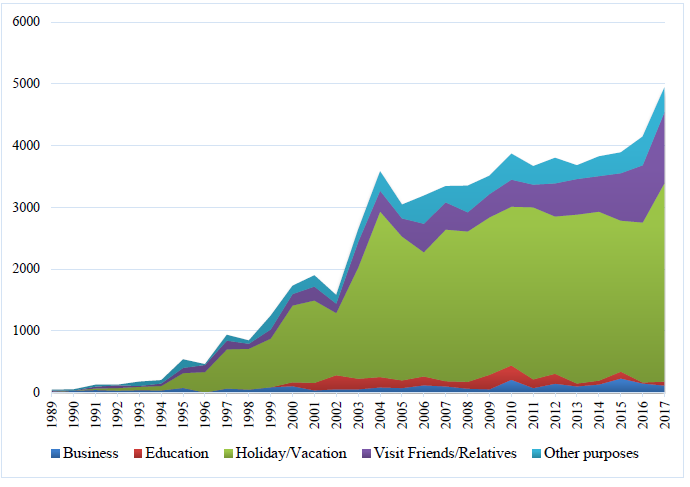
Note: Data for years 1989–1993 refer to Czechoslovakia.
Source: INFOS database, Stats NZ, http://www.stats.govt.nz/infoshare.
Table 1. Visitor arrivals by purpose, CEE EU-10 nationals, 2003–2018
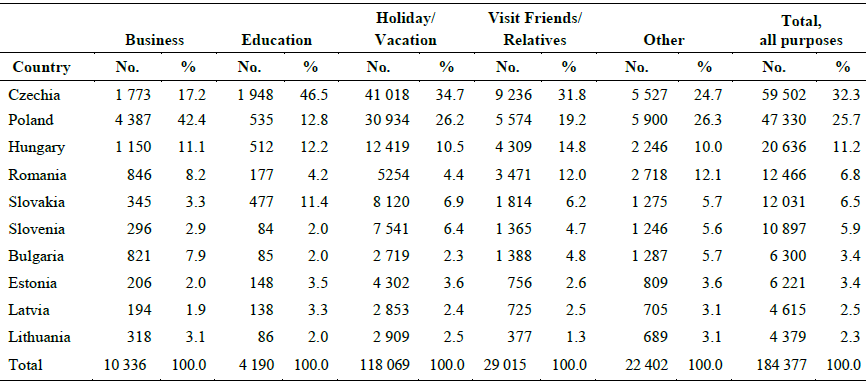
Source: Stats NZ (n.d. c). Author’s calculations; March years.
Figure 1 highlights that the predominant purpose of visiting New Zealand among Czech migrants has been for a holiday/vacation followed by visiting friends/relatives, which is also the case for migrants from the other CEE EU-10 countries, as observed in Table 1. Visitor numbers from Czechia for business purposes have been increasing but remain small. The number visiting for education has also been extremely limited from all the CEE EU-10 countries: 1 948 Czech visitors arrived for education in the observed period, contributing the largest share (46.5 per cent) of the total flow for education. Czechia contributes the largest flow across all categories except business, for which the largest number of arrivals over the observed period was from Poland at 4 837 arrivals, representing 42 per cent of the overall CEE EU-10 visitor flow for business.
Permanent and long-term (PLT) arrival data reflect the number of people who arrive with the intention to stay in New Zealand for at least 12 months. Overall, PLT arrivals and net migration from Czechia have been lower than visitor arrivals. As the data in Figure 2 indicate, during the 1990s, annual PLT net migration was below 100 and, between 2002 and 2005, was negative, reaching –40 in 2005. Following Czechia’s accession to the EU, and after a moderate decrease in PLT arrivals and PLT net migration in 2008–2009, PLT migration began steadily increasing, reaching 694 arrivals in 2015 and 746 in 2017. Some Czech migrants may have returned home in anticipation of the country’s EU accession but PLT arrivals and PLT net migration also started to increase in 2007, when Czechia joined the EU’s Schengen agreement and Czech nationals obtained full freedom of intra-EU travel. The decrease of Czech PLT arrivals during 2008–2009 was most probably due to the global financial crisis. Table 2 indicates that, overall, PLT migration from the CEE EU-10 countries has increased over the last 15 years and that Czechia contributes the largest share (53.8 per cent) while from most other CEE countries, the annual PLT flow has been below 100. The PLT flow of Romanians has been high (15.0 per cent); however, this flow reached its peak in the period 2002–2007 with annual arrivals of, on average, 179 people and has declined steadily since Romania’s accession to the EU in 2007.
Figure 2. PLT migration to New Zealand from Czechia 1989–2017 (March years)
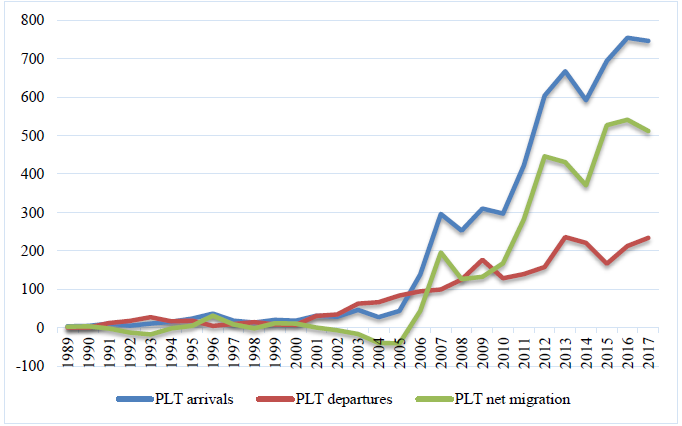
Note: Data for years 1989–1993 refer to Czechoslovakia.
Source: INFOS database, Stats NZ, http://www.stats.govt.nz/infoshare.
Table 2. PLT arrivals, departures and net PLT migration of the CEE countries’ nationals to New Zealand, 2003–2018
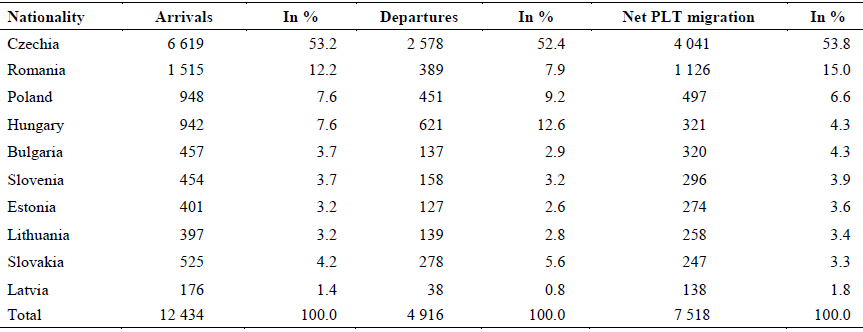
Notes: Sorted descending by net migration.
Source: Stats NZ (n.d. c). Author’s calculations; March years.
Temporary working visa and residency visa approvals
Immigration New Zealand data on the number of applications approved for temporary working visas and residency visas are presented in Table 3. In the last two decades, the number of temporary working visas approved for CEE EU-10 migrants in New Zealand has increased more than five-fold – from 741 in 1998 to 4 042 in 2018 – and by 2.4 times for residency visa approvals in the same period. Of the 69 537 visas approved, 86.4 per cent have been in the temporary work category.
Most Czech migrants appear to obtain temporary working visas rather than residency visas. Of the 30 469 visas approved for Czechs in the last 20 years, 94.7 per cent – 28 848 in total – were for temporary work, constituting 48 per cent of all approvals for CEE EU-10 migrants in the observed period. Between 1998 and 2004, the flow of temporary working migrants from the CEE EU-10 countries was dominated by Polish migrants, fluctuating between 500 and 600 approvals per year, followed by Czechia, Romania and Hungary. Of the total 28 848 Czech approvals, 96 per cent had their temporary working visas approved during the 2004–2018 period.
Considering residency visas, the largest number was for migrants from Romania, who make up 30.6 per cent of the total residency visas approved for CEE EU-10 migrants in the 1998–2018 period and 24.5 per cent of approvals during 2004–2018. Czech migrants’ approvals have accelerated since 1997, representing 20.4 per cent of approvals since 2004 and 17.1 per cent of approvals for the whole period. More than half (50.2 per cent) of residency visas approved in the period were for nationals of the Visegrad group countries: Czechia, Hungary, Poland and Slovakia.
The smallest share of temporary working visas in the same period was awarded to migrants from the Baltic States (Estonia, Latvia and Lithuania) and Bulgaria, who gained 10 per cent of total CEE EU-10 approvals. The Baltic States and Slovenia had the lowest share of the residency visas granted at 8.7 per cent of the total.
As shown in Table 4, Czech migration flows to New Zealand are mostly labour driven, with the number of applications for temporary working visas exceeding those for residency over the last ten years by more than 19 times. Migrants can apply for diverse temporary working visa categories but most migrants, including those from the CEE EU-10 countries, acquire visas in the Working Holiday Scheme (WHS), skilled work and relationship categories. For example, almost two-thirds (62.3 per cent) of temporary work visas approved for Czech migrants in the last ten years have been through the WHS, followed by the categories ‘other’, skilled work and relationship. The WHS is by far the largest category of temporary labour migration in New Zealand. It was established via a bilateral agreement between New Zealand and Japan in 1985 and now includes 45 countries following more recent expansion. The scheme allows young adults to holiday as well as to work and study in the country while honouring a reciprocal agreement between their home country and New Zealand. The total number of migrants who can participate in the WHS is unlimited for OECD countries such as Germany, the United Kingdom, France and the United States, which constituted the main share (80 per cent) of the 500 798 total WHS participants in 2008–2018 (Opara 2018). A WHS agreement was established with Czechia in 2004 allowing a limited number of participants – which increased from an initial limit of 100 to 1 200 and was even exceeded in some years (Immigration New Zealand 2017a). OECD countries with limited agreements include all the CEE EU-10 member-states except Romania and Bulgaria, and include other non-EU countries such as Chile, Spain, Israel and South Korea. Czechia had 12 618 participants in the period 2008–2018, second only to South Korea’s 20 627 participants in 2007–2017 (Opara 2018: 39).
Residency visas granted in the last ten years to CEE EU-10 migrants have mostly been through the skilled migrant and partnership categories – for example, 89 per cent of Czech residency visa approvals in 2008–2018 were under these categories. Data on residence visa approvals for the period July 2006–July 2017 indicate that, of 417 residency visas granted to principal Czech applicants in the partnership category, 77.7 per cent (324) were to females, while 80.4 per cent of the 332 visas in the skilled migrant category went to males (Immigration New Zealand n.d. a). From 2008 to 2018, the partnership and skilled migrant categories made up 85.6 per cent and 76.9 per cent of residency visa approvals for Hungary and Romania respectively. Only Estonia’s residency visa approvals were dominated by the partnership category rather than skilled migrants and, of the three Baltic states, Latvia had the highest overall number of residency approvals.
Of the 4 549 residency visas approved for CEE EU-10 nationals since 2008, just 20 migrants from Czechia have been granted residency in the refugee category. Total approvals in the child, sibling and parent categories have been very low. In 2015/2016, the median age of Czech nationals granted residency as skilled migrants was 29 – with over half (57 per cent) aged 20–29 – and 36 per cent constituted the age group 30–39 years (Ministry of Business, Innovation and Employment 2016). The average size of resident applications measured as people per application varied between 1.0 and 1.9 in the period 1997/98 to 2015/16 for Czechia and was 1.3 in 2015/2016. Most applicants were, therefore, likely to be either young adult individuals without partners or young adult couples without children.
Table 3. Temporary work and residency visas approved by nationality, CEE EU-10 countries, 1998–2018 (end of June years)
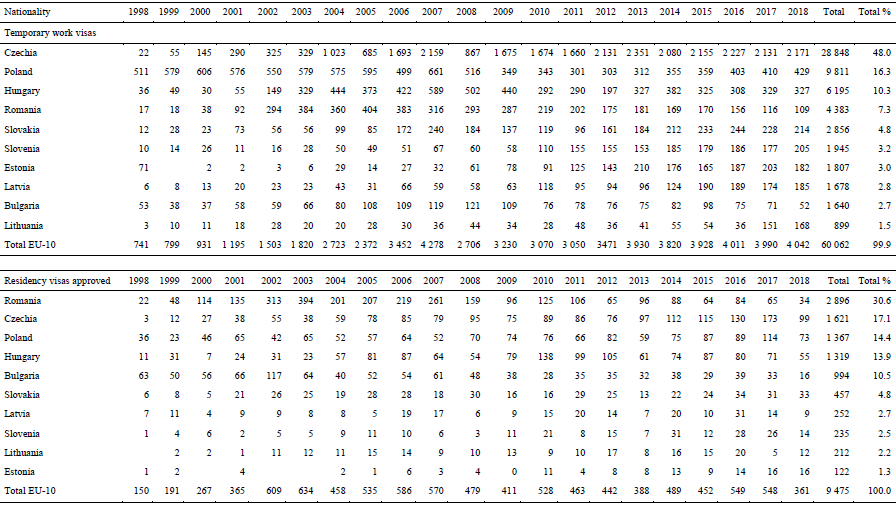
Source: Department of Labour (2011); Ministry of Business, Innovation and Employment (2018).
Table 4. Temporary work and residency visas approved by category and nationality, CEE EU-10, 2008–2018 (end of June years) in total
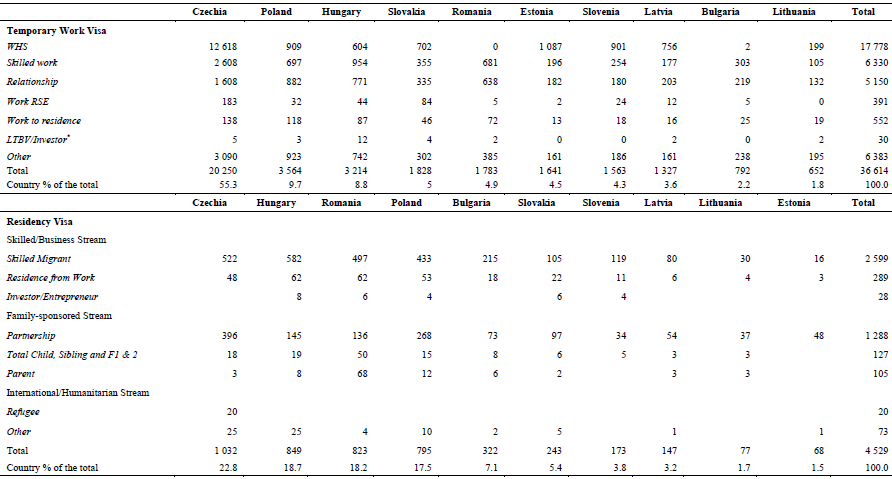
Note: * The Recognised Seasonal Employer (RSE) scheme came into effect in April 2007. The policy allows the horticulture and viticulture industries to recruit workers from overseas for seasonal work when there are not enough New Zealand workers. People employed under the RSE policy may stay in New Zealand for up to 7 months during any 11-month period. LTBV stands for long-term business visa.
Source: Department of Labour (2011), Ministry of Business, Innovation and Employment (2018).
Migrant transitions: from temporary work and from residency applications
Data presented in Table 5 indicate that only 3 per cent of first-time temporary working visa holders from Czechia gained New Zealand residency within three years of obtaining their initial work visas in the period between 2009/2010 and 2012/2013. A relatively high portion of temporary working Czech migrants in the essential skills category – 26, 24 and 29 per cent in three consecutive three-year periods from 2010/2011, respectively – did transition to residency within three years (Ministry of Business, Innovation and Employment 2016). However, according to the Ministry of Business, Innovation and Employment (2018) data, 91 per cent of essential skills Czech migrants leave New Zealand immediately upon the conclusion of their visa and 95 per cent leave within five years while, for Polish essential skills migrants, these exit rates are 77 per cent and 84 per cent respectively. As presented in Table 5, the highest proportion (18–48 per cent) of migrants gaining residency from first-time temporary work was from Romania, followed by Hungary and Poland, although temporary work visa holders from these countries are far outnumbered by those from Czechia.
Most migrants who gain residency remain in New Zealand for at least five years (Ministry of Business, Innovation and Employment 2016). Data presented in Table 6 show that, of the 650 Czech migrants who applied offshore and were granted residency between 2008/2009 and 2014/2015, nearly all (643) successfully arrived in New Zealand to take up residency, with 87 per cent still being resident in New Zealand as of June 2016. Similar retention rates are observed in Table 6 for migrants from other CEE countries.
Table 5. Proportion of first-time temporary workers gaining residence within three years, top 7 CEE EU-10 countries, 2009/10–2012/13

Source: Ministry of Business, Innovation and Employemnt (2016). Transitions and retention dataset.
Table 6. Proportion of migrants in New Zealand as of 30 June 2016, top 5 CEE EU-10 countries, 2008/09–2014/15

Source: Ministry of Business, Innovation and Employment (2016). Transitions and retention dataset.
Czechs in New Zealand today: migrant stocks
The number of Czechia-born people in New Zealand remains small, although the 2001 New Zealand census shows a significant increase in the population usually resident in New Zealand, which more than doubled between 2001 and 2013, reaching 1 287 as indicated in Table 7. There were 1 659 people present in New Zealand on the day the census was carried out who reported identifying as belonging to the Czech ethnic group. Czechoslovakia-born migrants numbered 118 in 1921, decreasing to 72 in 1936. ‘Czechoslovakia’ refers to the sovereign state that gained independence from the Austro-Hungarian Empire in 1918, while Czechia and Slovakia are the republics into which Czechoslovakia dissolved in 1993. Limited arrivals, between 300 and 400, followed the 1948 Communist coup in Czechoslovakia. One hundred refugees from Czechoslovakia were also accepted and assisted by the government with accommodation and employment in 1968–1969, after the suppression of the 1968 Prague Spring by Warsaw Pact forces (McGill 1982; Wilson 2015). The 2013 census population count of Czechia-born people, including visitors from overseas, reached 1 953 people (of whom 1 287 reported being ‘usually resident’ in New Zealand), reflecting a high proportion of temporary migrants.
Following the 2004/2007 accession of CEE countries to the EU, 2006 and 2013 census data show that the population of migrants from these countries, including Czechia as well as Russia, Ukraine and Belarus, has increased significantly – by 16.3 per cent (Stats NZ n.d. a). Meanwhile, the stock of migrants from the former Yugoslavia/South Eastern Europe (SEE) has declined by 8.9 per cent, the most prominent decreases being among migrants from Croatia and Macedonia. As Table 7 shows, when considering only the CEE EU-10 countries, the growth of the CEE migrant stock in New Zealand is more moderate (8.1 per cent). Nevertheless, in this period, the only migrant stock decreases were for Poland (–2.9 per cent) and Romania (–2.0 per cent). The Czech migrant stock was, as of 2013, the fourth largest among the EU-10 countries, behind Poland (1 947) and Hungary (1 371), and the seventh largest when compared to both the EU-10 and the above-mentioned SEE/non-EU migrant stocks. Russians numbered the highest in 2013 at 5 469. However, the stock of migrants born in Czechia has had the highest growth at 44 per cent, up from 894 to 1 287 people – disregarding the 59 per cent increase in the Lithuanian migrant stock due to its much smaller increase in absolute terms (from 117 to 186 people).
The Czechia-born stock of migrants usually resident in New Zealand in 2013 arrived recently; in other words, the stock is relatively new. Compared to the Russian, Hungarian, and Polish ethnic groups of overseas-born migrants, Czechs had the largest proportion – nearly half (46.6 per cent) – of their usually resident population arrive in the last four years, while only 22.8 per cent of all overseas-born migrants arrived in the same period, at the time of the census (see Table 8). On average, 79.9 per cent of the CEE and Russian populations arrived in the post-communist era (after 1993) and very few Russians arrived before this, as would be expected. Furthermore, only 11.8 per cent of Czechs arrived 20 or more years ago but over one third (37.8 per cent) of Polish migrants and over a quarter (26.5 per cent) of Hungarians arrived in New Zealand 20 or more years ago. The 2011 Australian census recorded 7 437 Czechia-born people present in Australia, of whom 75.1 per cent arrived prior to 2001 (Department of Immigration and Citizenship 2011).
Table 7. Birthplace for the census usually resident population count, CEE EU-10 countries, selected census years, 1921–2013

Sources: Lochore (1951), Stats NZ (n.d. a), Wilson (2015: 5).
Table 8. Ethnic groups (detailed total responses) by years since arrival in New Zealand, overseas-born usually resident population count, 2013 census

Note: Ethnic groups (detailed total responses) include all people who reported belonging to each ethnic group, whether as their only ethnic group or as one of several. Where a person reported belonging to more than one ethnic group, they were counted in each applicable group. Selected ethnic groups presented in this table are for those in which 1 000 or more responses were recorded for the 2013 census usually resident population.
Source: Author’s calculations based on Statistics New Zealand 2013 census data.
Czechs in New Zealand today: socio-demographic characteristics
Sex and age
The 2013 census data presented in Figure 3 indicate that Czechia-born usually resident people in that year were a mostly young adult population, with its largest shares in the 30–39-year age group (42 per cent of all usually resident Czech nationals) and the 15–29-year group (30 per cent). The usually resident migrant population from Latvia, Poland, Hungary and Estonia had by far the highest shares of their usually resident populations represented by the 65 years and older age group. Census data from the same year indicate that 54.5 per cent of the Czechia-born population were female, and that only Slovakia had a larger female share of its population in the 30–39 age group, at 44 per cent. Slightly lower female proportions in the 15–29 and 30–39 groups are observed for Romania, Slovenia, Lithuania and Estonia.
Education
The 2013 Census data presented in Figure 4 suggest that, generally, the educational profile of Czech migrants usually resident in New Zealand is more heavily skewed towards Bachelor’s and higher degrees (such as Bachelor’s honours, Master’s and PhD degrees) than the New Zealand-born population. For example, in 2013, 5.4 per cent of Czechs reported having no qualification, while the share of New Zealand-born residents with no qualification was 22.3 per cent. In 2013, Bachelor’s degree rates were comparable across the two nationalities though Czechs far outnumbered New Zealanders in the higher degree category, which represented 13.7 and 4.4 per cent for each country respectively. The data in Figure 4 also suggest a strongly gendered pattern in the educational profile of Czech migrants in New Zealand. In 2013 there were more Czech females than males who held either a Bachelor’s or higher degree, while the New Zealand-born population’s educational profile was slightly female-dominant in 2013.
Figure 3. CEE EU-10 migrants usually resident in New Zealand by age group (%), 2013 census
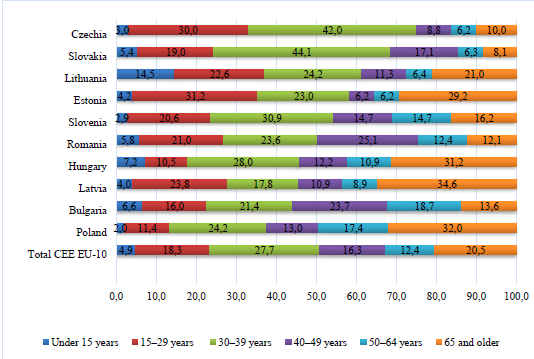
Source: Author’s calculations based on Statistics New Zealand 2013 census data.
Figure 4. Highest educational qualification of the population aged 15+ years by birthplace (%), 2013 census
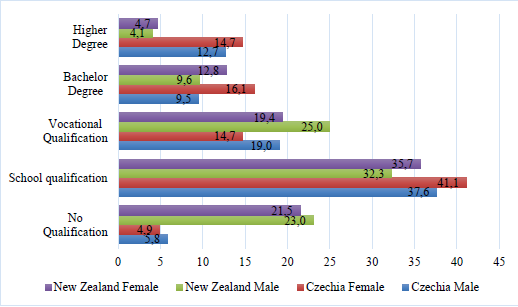
Source: Author’s calculations based on Statistics New Zealand 2013 census data.
Employment
The labour market position of Czechia-born migrants, compared with that of the New Zealand-born population, according to the 2013 census, is presented in Figure 5. In general, across both countries, males have higher rates of full-time employment and labour-force participation. However, the Czechia-born population’s employment profile is, on average, more gender-balanced than that of New Zealanders. For example, in 2013, 82 per cent of New Zealand-born males and 59.7 per cent of New Zealand-born females were in full-time employment, while 86.1 per cent and 71.5 per cent of Czechia-born males and females had full-time employment respectively. A similar trend for Czechia- and New Zealand-born rates of self-employment without employees is also evident. Czech migrants have a more gender-balanced though slightly lower self-employment rate than the New Zealand-born population (see Figure 6).
Figure 5. Labour force status of the population aged 15+ years by birthplace and gender (%), 2013 census
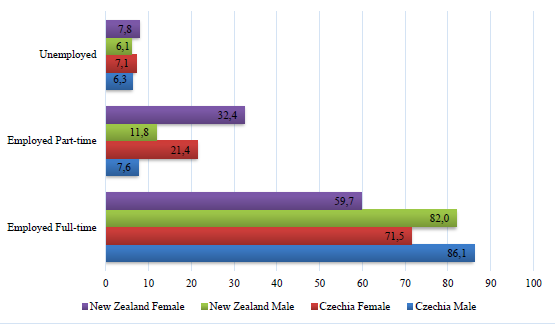
Source: Author’s calculations based on Statistics New Zealand 2013 census data.
Figure 6. Status in employment by birthplace and gender for employed population resident in New Zealand aged 15+ (%), 2013 census
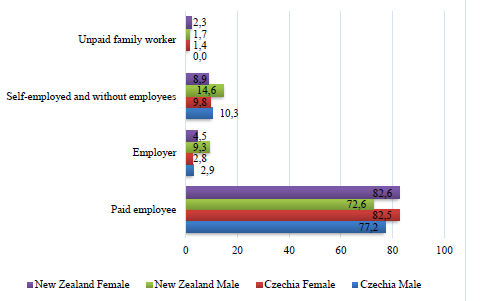
Source: Author’s calculations based on Statistics New Zealand 2013 census data.
Occupational status
The data presented in Figure 7 suggest that, in the occupational profile of Czech migrants in New Zealand, the top 5 categories are ‘Managers’, ‘Professionals’, ‘Technicians and trades workers’, ‘Labourers’ and ‘Clerical and administrative workers’. This reflects closely the occupational profile of the 2013 New Zealand-born population, for whom the fifth-largest category was ‘Machinery operators and drivers’ rather than ‘Clerical and administrative workers’. Again, a potential gendered pattern in the labour market outcomes of Czech migrants is observable due to the significant gender-ratio imbalances present here (as there is for the New Zealand-born population). For example, in 2013, 22.4 per cent of Czech females were employed as ‘Community and personal service workers’ while only 8.1 per cent of Czech males held employment in the same category. For the New Zealand-born population in 2013, these rates were 12.3 and 4.9 for females and males respectively. As expected, in both groups, males heavily outnumbered females in ‘Construction’ work while females dominated over males in ‘Accommodation and food services’ roles (see Table 9).
Figure 7. Occupation by birthplace and gender for employed population resident in New Zealand aged 15+ (%), 2006, 2013 census
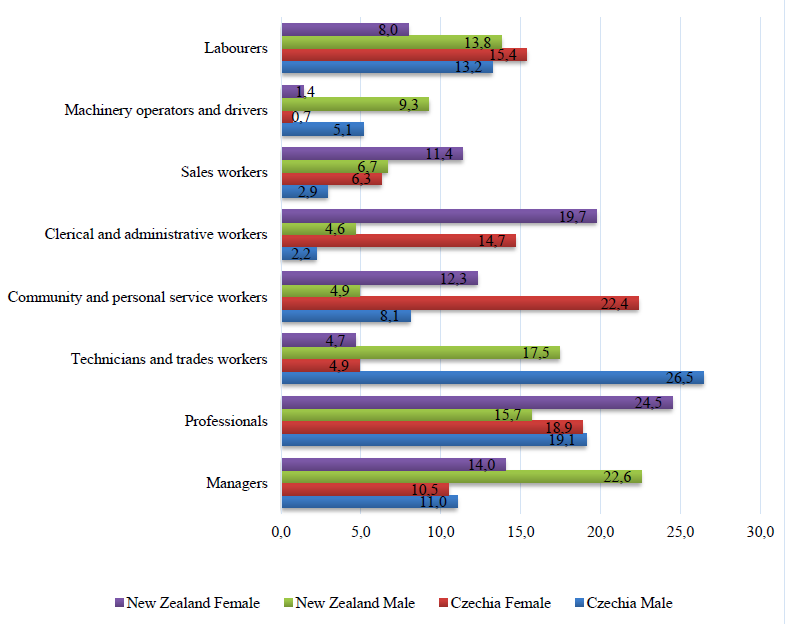
Source: Author’s calculations based on Statistics New Zealand 2013 census data.
Table 9. Employment in industries by birthplace and gender for employed population resident in New Zealand aged 15 and over (%), 2006 and 2013 censuses
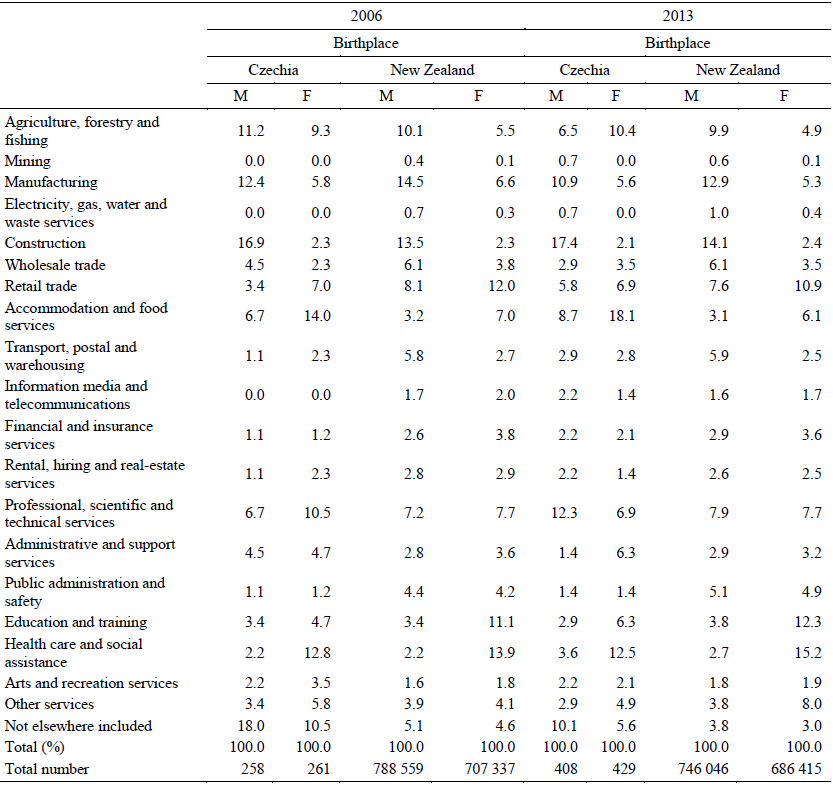
Source: Author’s calculations based on New Zealand Census of Population and Dwellings 2006 and 2013.
Language
In general, most Czechia-born migrants usually resident in New Zealand report being able to speak English, as indicated by the 2006–2013 census data presented in Table 10. In 2013, no age group had an average English-speaking rate lower than 84.6 per cent. On average, female Czechia-born migrants in New Zealand appear to have a slightly higher rate of English-speaking ability than Czechia-born males, across the 2006–2013 census years.
Table 10. English language spoken by Czech-born people by sex and age group (%), 2006 and 2013 censuses

Source: Author’s calculations based on New Zealand census data for 2006 and 2013.
Discussion and concluding remarks: Czech–NZ liquid migration
The results of this study confirm that, despite emigration from Czechia being the lowest among the 10 CEE countries since the 1990s, migration from Czechia to New Zealand is: (1) increasing, especially since the 2004 eastward enlargement of the EU; (2) the largest, youngest and most recently arrived migrant group from the CEE EU-10 countries; (3) a considerable portion of overall Czech emigration; and (4) mostly for temporary work via the WHS, or travel/tourism, seeing friends/relatives and business rather than long-term education or permanent settlement (gaining residence). Furthermore, nearly all temporary work visa holders from Czechia apparently leave New Zealand at the end of their visa either immediately or within five years. The evidence presented in this article supports the hypothesis that Czechia-New Zealand migration can be understood as an example of twenty-first-century liquid migration that extends beyond the EU: it is temporary, labour-driven and open-ended, with unpredictable patterns of onward migration. Czechs staying transiently in New Zealand may be characterised as ‘young migrants […] without family obligations and without clear plans concerning their future life’ (Glorius et al. 2013: 8), who leave their homeland for a faraway destination under no certainty that they will stay long term or even successfully gain residency or work should they apply for a visa. Many Czechs appear to be arriving in New Zealand initially as tourists but with sufficient skills and work experience to become socially and economically anchored, capitalise on New Zealand’s diverse labour opportunities and Working Holiday Scheme, and eventually transition to a different migrant status or become temporary migrants elsewhere – such as Australia, where there are similar economic and social opportunities. It is yet to be seen whether there will be a similar uptake of working holiday visas with the newly established (in March 2018) Working Holiday Visa programme between Australia and Czechia (The Australian Trade and Investment Commission n.d.).
The number of Czechs gaining residence and settling long term remains dwarfed by the temporary flow of Czech migrants, which could be partly explained by the social marginalisation of some migrants in New Zealand (for example due to their foreign accent), including Czechs (Nadkarni 2017; Tan 2018). Nevertheless, the community of Czechia-born people usually resident in the country has been growing faster than the stocks of migrants from other CEE EU-10 countries. The Czech migrant stock appears to be well-educated, with high rates of English-language ability and participation in the labour force, taking up similar professions to the New Zealand-born population. The relatively highly skilled and educated character of the Czech migrant stock in New Zealand can be linked to concerns expressed by International Monetary Fund (IMF) researchers about a potential ‘brain drain’ and ‘skills drain’ in Europe (Atoyan, Christiansen, Dizioli, Ebeke, Ilahi, Ilyina, Mehrez, Qu, Raei, Rhee and Zakharova 2016: 5). The IMF drew attention to the unusually large emigration from CEE and Southern Europe being made up of mostly the young and educated, suggesting that, although this emigration may lead to positive outcomes for the migrants themselves, the large-scale outflows of skilled workers could adversely affect sending countries’ labour forces and productivity, in turn slowing economic growth (Nadeem, Ilyina and Zakharova 2016).
Survey data from 2005–2007 suggest that Czech information technology (IT) specialists favour New Zealand and Australia, alongside other Anglo-Saxon countries, including the United States, Canada and England, as a place to live and work (Vavrečková and Baštýř 2009: 22). The standardisation of technology and the transferable nature of skills in the IT industry are well suited to deliberately open-ended, liquid migration and it is therefore possible that Czech IT specialists move between New Zealand and Australia and on to other destinations frequently and temporarily, taking advantage of flexible immigration frameworks and diverse employment opportunities. As Hugo (2011: 70) notes in the context of temporary migration to Australia, ‘patterns of onward migration are greatest for skilled persons and least for unskilled’. Thus, even those Czech migrants who settle in New Zealand as residents and work in skilled industries such as IT may not necessarily all be settling ‘for good’ but, rather, ‘anchoring’ here for ‘relative stability rather than putting down roots’ (Grzymała-Kazłowska and Brzozowska 2017: 1) at a final destination. There is already some evidence to suggest that Czech nurses engage in this kind of liquid anchoring when working in unusual overseas destinations such as Saudi Arabia, where ‘Due to accessible transport, communication and information technologies’ and their internationally transferable skills they ‘have many more opportunities for migration, including country hopping, commuting or circular migration to many countries around the globe’ along ‘very individual and dynamically evolving’ paths (Di Cara 2016: 202).
The Czech community in New Zealand is more female than male, reflecting the quantitative dominance of women in migrant populations from other CEE EU-10 countries since the beginning of the post-communist era (Fassman et al. 2014: 50; Morokvasic 2004). Female Czech migrants in New Zealand also appear to arrive with higher educational levels and rates of spoken English and they gain residence through partnership more frequently than their male counterparts. Nearly twice as many Czech women also appear to work in ‘Community and personal service’ jobs than do New Zealand women. However, the gendered implications of these observations – while undoubtedly important – require further investigation that is beyond the scope of this article.
So why is New Zealand an attractive destination for young adult Czech migrants seeking temporary work and travel, especially when all CEE EU-10 migrants have the same opportunity to visit New Zealand and stay for up to nine months without a visa, as well as move freely for work, tourism and study closer to home within the EU? While detailed qualitative research is needed to answer the question robustly, it can be suggested that Czechia’s relatively high standard of living among the CEE EU-10 countries means that Czech migrants may be more likely to afford the long-distance travel and risky journey to New Zealand to take advantage of its flexible migration pathways such as the WHS, whereas migrants from lower-income-level countries such as Poland, Romania and Bulgaria move more predominantly East-to-West within the EU, attracted by the geographic proximity of different labour market opportunities and low wage differentials in neighbouring states (Fassman et al. 2014: 45). The average proportion of time a WHS participant spends earning wages/salaries in New Zealand under the WHS and the gross national income per capita of their country of origin are strongly negatively correlated (OECD 2014: 70). Data from 2009 indicated that Czech WHS participants spent approximately 65 per cent of their visa duration working, while migrants from Latvia spent almost 75 per cent of their time earning wages/salaries and participants from higher-income countries such as Norway, Denmark and Germany worked for only around one third of their visa duration (OECD 2014: 70). This evidence supports the suggestion that temporary labour migrants from Czechia to New Zealand are economically motivated individuals attracted by a positive wage differential and flexible options for tourism, improving language skills and onward migration. This evidence also points to a problematic tension in the WHS whereby some privileged young migrants from OECD countries seem to be harnessing the benefits of liquid ‘lifestyle’ migration in New Zealand, spending on average less than half of their visa duration working, while migrants from relatively lower-income countries such as Czechia and other non-OECD states such as Argentina typically spend over half of their time working – and may, in rare cases, be reliant on temporary work for survival or for supporting their families back home (Opara 2018).
Qualitative – albeit limited – academic research and New Zealand media sources can lend a human face to the discussion of liquid Czech migration. For example, in a video interview conducted by New Zealand Immigration, Czech migrant Lukas Pohl explained how he ‘wasn’t really planning to settle’ in the country when he arrived in Auckland in December 2011, initially via the WHS (Immigration New Zealand n.d. b). Transitioning through several jobs related to his experience in outdoor activities and software engineering, Pohl took advantage of different opportunities as they arose and eventually gained permanent residence although he emphasised that his future remains ‘wide open’ given his status as a skilled, young adult worker with no mortgage, children or partner and overall high satisfaction with an open-ended New Zealand lifestyle (Immigration New Zealand n.d. b). In 2016, The New Zealand Herald highlighted a similar story about Ondra Geryk, a Czech migrant who also cited New Zealand’s ample work opportunities and low corruption rates as motivating factors for his decision to move to the country (Small 2016). Like Pohl, Geryk initially travelled alone around the North Island, New Zealand’s most populous and economically active region, before developing a friendship network and securing stable employment in Christchurch, a burgeoning, formerly earthquake-damaged city in the South Island (Small 2016).
Procházková (2012) investigated seasonal migrant work in horticulture (orchards) in rural New Zealand, discussing how some young Czech migrants arrived as short-term tourists, lacked the necessary funds to qualify for the WHS and engaged in irregular work in order to afford a different visa type. Only a few of the study participants made the full transition from a tourist visa to a temporary working visa and eventually took up residency. These findings show how Czech migrants’ behaviour and motivations in New Zealand align with characteristics of liquid migration: temporariness, unpredictability and a readiness to move elsewhere when things do not go as planned or other labour opportunities arise. Procházková, a Czech national herself, worked in orchards as a temporary labour migrant before transitioning to postgraduate university study.
In conclusion, it is difficult to predict how Czech migration to New Zealand will evolve. However, this flow stands out among the diverse movements of CEE EU-10 people to the country and it may be the most productively understood within the theoretical framework of liquid migration. The trends and patterns highlighted in this article deserve further, detailed qualitative investigation, particularly at an individual personal level, in order to develop a clearer understanding of the lived experiences of Czech migrants in New Zealand and the different choices they make to become socially and economically anchored there – often, but not always, on a temporary basis, with unpredictable onward movements to other parts of the world.
Conflict of interest statement
No potential conflict of interest was reported by the author.
ORCID ID
Oksana Opara  https://orcid.org/0000-0002-9895-0084
https://orcid.org/0000-0002-9895-0084
Notes
1 Puhoi is one of only two ethnic villages in New Zealand, the other being Akaroa, a French settlement in the South Island. For further information about Puhoi and the contribution of Czech migrants to New Zealand culture and society, see Silk (1923); Thompson (2013); Wilson (2015); Wood (2012). For information about the Bohemian Association of New Zealand, see https://bohemianassociation.wordpress.com.
References
Atoyan R., Christiansen L., Dizioli A., Ebeke C., Ilahi N., Ilyina A., Mehrez G., Qu H., Raei F., Rhee A., Zakharova D. (2016). Emigration and Its Economic Impact on Eastern Europe. IMF Staff Discussion Note SDN/16/07. International Monetary Fund. Online: https://www.imf.org/external/pubs/ft/sdn/2016/sdn1607.pdf (accessed: 21 October 2018).
Bauman Z. (2000). Liquid Modernity. Cambridge: Polity Press.
Beaglehole A. (2015). Immigration Regulation. Immigration Policy: Overview. Te Ara – The Encyclopaedia of New Zealand. Online: http://www.TeAra.govt.nz/en/immigration-regulation/page-1 (accessed: 21 October 2018).
Bedford R. (2000). A Robust Research/Policy Interface: International Migration and Social Transformation in the Asia-Pacific Region, in: R. Bedford (ed.), Perspectives on International Migration, Urban Social Transformation and the Research/Policy Interface, pp. 30–40. Hamilton: University of Waikato, Population Studies Centre. Online: http://www.waikato.ac.nz/__data/assets/pdf_file/0016/74140/dp-36.pdf (accessed: 21 October 2018).
Bedford R., Ho E., Lidgard J. (2001). Immigration Policy and New Zealand’s Development into the 21st Century: Review and Speculation. Asian and Pacific Migration Journal 10(3–4): 585–616.
Black R., Engbersen G., Okólski M., Panţîru C. (2010). A Continent Moving West? EU Enlargement and Labour Migration from Central and Eastern Europe. Amsterdam: Amsterdam University Press.
Castles S. (1998). New Migrations in the Asia-Pacific Region: A Force for Social and Political Change. International Social Science Journal 50(156): 215–228.
Czech Ministry of Foreign Affairs (2010). Czechs Abroad. Official Visitor Website of the Czech Republic Operated in Cooperation with Czech Radio and Radio Prague. Online: http://www.czech.cz/en/62194-czechs-abroad (accessed: 21 October 2018).
Department of Immigration and Citizenship (2011). Community Information Summary: Czech-Republic born. Australian Government. Online: https://www.homeaffairs.gov.au/LifeinAustralia/Documents/MulticulturalAf... (accessed: 21 October 2018).
Department of Labour (2011). Residence Decisions. Excel spreadsheet. New Zealand Government. Online: link unavailable (accessed June 2011).
Di Cara V. (2016). Trends, Motivations and Experiences of Czech Migrant Nurses: A Mixed Methods Study. Unpublished PhD thesis. Edinburgh: Queen Margaret University. Online: https://eresearch.qmu.ac.uk/handle/20.500.12289/7388 (accessed: 21 October 2018).
Dragostinova T., Gerlach D. (2017). Demography and Population Movements, in: I. Livezeanu, A. von Klimo (eds), The Routledge History of East Central Europe Since 1700, pp. 126–175. London, New York: Routledge.
Drbohlav D. (2012). Patterns of Immigration in the Czech Republic, Hungary and Poland, in: M. Okólski (ed.), European Immigrations: Trends, Structures and Policy Implication, pp. 179–209. Amsterdam: Amsterdam University Press.
Drbohlav D., Janská E. (2009). Illegal Economic and Transit Migration in the Czech Republic: A Study of Individual Migrants’ Behaviour. Europe–Asia Studies 61(1): 141–156.
Drbohlav D., Lachmanová-Medová L., Čermák Z., Janská E., Čermáková D., Dzúrová D. (2009). The Czech Republic: On Its Way from Emigration to Immigration Country. IDEA Working Paper No 11. Cork: University of Cork.
Duszczyk M., Matuszczyk K. (2014). Migration in the 21st Century from the Perspective of CEE Countries – an Opportunity or a Threat? Warsaw: Central and Eastern Europe Development Institute.
Engbersen G. (2012). Migration Transitions in an Era of Liquid Migration: Reflections on Fassmann and Reeger, in: M. Okólski (ed.), European Immigrations: Trends, Structures and Policy Implications, pp. 91–105. Amsterdam: Amsterdam University Press.
Engbersen G., Snel E. (2013). Liquid Migration. Dynamic and Fluid Patterns of Post-Accession Migration Flows, in: B. Glorius, I. Grabowska-Lusińska, A. Kuvik (eds), Mobility in Transition: Migration Patterns After EU Enlargement, pp. 21–40. Amsterdam: Amsterdam University Press.
European Commission (2010). Geographical and Labour Market Mobility. Special Eurobarometer 337. Online: http://ec.europa.eu/commfrontoffice/publicopinion/archives/ebs/ebs_337_e... (accessed: 21 October 2018).
Fassmann H., Kohlbacher J., Reeger U. (2014). The Re-Emergence of European East–West Migration: The Austrian Example. Central and Eastern European Migration Review 3(2): 39–59.
Favell A. (2008). The New Face of East–West Migration in Europe. Journal of Ethnic and Migration Studies 34(5): 701–716.
Glorius B., Grabowska-Lusińska I., Kuvik A. (eds) (2013). Mobility in Transition: Migration Patterns After EU Enlargement. Amsterdam: Amsterdam University Press.
Goździak E. M., Pawlak M. (2016). Theorizing Polish Migration Across Europe: Perspectives, Concepts, and Methodologies. Sprawy Narodowościowe 48: 106–127.
Górny A. (2017). Eastwards EU Enlargements and Migration Transition in Central and Eastern Europe. Geografie 122(4): 476–499.
Grabowska-Lusińska I. (2013). Anatomy of Post-Accession Migration: How to Measure ‘Liquidity’ and Other Patterns of Post-Accession Migration Flows, in: B. Glorius, I. Grabowska-Lusińska, A. Kuvik (eds), Mobility in Transition: Migration Patterns After EU Enlargement, pp. 41–64. IMISCOE Research Series. Amsterdam: Amsterdam University Press.
Grzymała-Kazłowska A. (2017). From Connecting to Social Anchoring: Adaptation and ‘Settlement’ of Polish Migrants in the UK. Journal of Ethnic and Migration Studies 44(2): 252-269.
Grzymała-Kazłowska A., Brzozowska A. (2017). From Drifting to Anchoring. Capturing the Experience of Ukrainian Migrants in Poland. Central and Eastern European Migration Review 6(2): 1–22.
Hall D. (ed.) (2017). Fair Borders? Migration Policy in the Twenty-First Century. Wellington: BWB Texts.
Hawthorne L. (2014). A Comparison of Skilled Migration Policy: Australia, Canada and New Zealand. Online: https://papers.ssrn.com/sol3/papers.cfm?abstract_id=2808881 (accessed: 21 October 2018).
Hugo G. (2011). The Changing Dynamics of the Australia/Asia-Pacific Migration System and its Implications for Australian International Migration Policy. Canberra: Department of Immigration and Citizenship. Online: https://www.homeaffairs.gov.au/ReportsandPublications/Documents/research... (accessed: 21 October 2018).
Immigration New Zealand (n.d. a). Research and Statistics. Online: http://www.immigration.govt.nz/about-us/research-and-statistics/statistics (accessed: 21 October 2018).
Immigration New Zealand (n.d. b). Hooked on Christchurch. New Zealand Now. Online: https://www.newzealandnow.govt.nz/resources/hooked-on-christchurch (accessed 21 October 2018).
Immigration New Zealand (2017a). Czech Working Holiday Visa. Online: https://www.immigration.govt.nz/new-zealand-visas/apply-for-a-visa/about... (accessed: 21 October 2018).
Immigration New Zealand (2017b). Visa Waiver Countries. Online: https://www.immigration.govt.nz/new-zealand-visas/apply-for-a-visa/tools... (accessed: 21 October 2018).
Ip M. (ed.) (2003). Unfolding History, Evolving Identity: The Chinese in New Zealand. Auckland: Auckland University Press.
King R. (2018). Theorising New European Youth Mobilities. Population, Space, Place 24(1): 1–12.
Kukral M. A. (2004). Czech Settlements in 19th Century Cleveland, Ohio. East European Quarterly 38(4): 473–484.
Lidgard J., Bedford R., Goodwin J. (1998). Transformations in New Zealand’s International Migration System: 1981–1996. Population Studies Centre Discussion Paper 25. Hamilton: University of Waikato.
Lochore R. A. (1951). From Europe to New Zealand: An Account of Our Continental European Settlers. Wellington: A. H. & A. W. Reed, in conjunction with the New Zealand Institute of International Affairs and with the assistance of the Department of Internal Affairs.
McGill D. (1982). The Other New Zealanders. Wellington: Mallinson Rendel.
Ministry of Business, Innovation and Employment (2016). Migration Trends 2015/16. Online: http://www.mbie.govt.nz/info-services/immigration/migration-research-and... (accessed: 21 October 2018).
Ministry of Business, Innovation and Employment (2018). Migration Trends 2016/17. Online: http://www.mbie.govt.nz/info-services/immigration/migration-research-and... (accessed: 21 October 2018).
Moreh C. (2014). Prestige and Status in the Migration Process: The Case of Social Differentiation in a Romanian ‘Community’ in Spain. Journal of Ethnic and Migration Studies 40(11): 1758–1778.
Morokvasic M. (2004). ‘Settled in Mobility’: Engendering Post-Wall Migration in Europe. Feminist Review 77: 7–25.
Nadeem I. N., Ilyina A., Zakharova D. (2016). Emigration Slows Eastern Europe’s Catch Up with the West. IMF Blog: Insights and Analysis on Economics and Finance. International Monetary Fund. Online: https://blogs.imf.org/2016/07/20/emigration-slows-eastern-europes-catch-... (accessed: 21 October 2018).
Nadkarni A. (2017). A Foreign Accent Could Limit Your Career. Stuff, 31 August. Online: https://www.stuff.co.nz/business/95977761/a-foreign-accent-could-limit-y... (accessed: 21 October 2018).
NZ Department of Labour, Immigration Division (1986). Review of Immigration Policy, August 1986. Wellington: V. R. Ward.
NZ Parliamentary Library (2008). Immigration Chronology: Selected Events 1840–2008. Research Paper 2008/01. Wellington: NZ Parliamentary Library.
OECD (2007). International Migration Outlook 2007. Paris: OECD Publishing.
OECD (2014). Recruiting Immigrant Workers: New Zealand 2014. Paris: OECD Publishing.
OECD (2017). International Migration Outlook 2017. Paris: OECD Publishing.
Okólski M. (2001). Incomplete Migration: A New Form of Mobility in Central and Eastern Europe. The Case of Polish and Ukrainian Migrants, in: C. Wallace, D. Stola (eds), Patterns of Migration in Central Europe, pp. 105–128. Basingstoke: Palgrave Macmillan.
Okólski M. (2007). Europe in Movement: Migration from/to Central and Eastern Europe. CMR Working Papers 22(80). Warsaw: University of Warsaw, Centre of Migration Research.
Okólski M. (ed.) (2012). European Immigrations: Trends, Structures and Policy Implications. Amsterdam: Amsterdam University Press.
Opara O. (2018). From Settler Society to Working Holiday Heaven? Patterns and Issues of Temporary Labour Migration to New Zealand. New Zealand Sociology 33(1): 29–52.
Pařízková A. (2011). Czech Migrants in the European Migration Space. Migracijske i etničke teme 27(2): 177–197.
Procházková J. (2010). Bohemians in New Zealand: The History and Present Situation of the Puhoi Village. Český lid 97(1): 19–34.
Procházková J. (2012). Foreign Seasonal Workers in New Zealand Horticulture: An Ethnographic Account of the Nexus of Labour and Immigration Policies and Employment Practices. Unpublished PhD thesis. Dunedin: University of Otago. Online: http://hdl.handle.net/10523/3648 (accessed: 21 October 2018).
Silk D. V. (1923). A History of Puhoi: A Historical Narrative of the People of Puhoi, Dedicated to the Pioneers Living and Dead. Dunedin: N. Z. Tablet Printing and Publishing.
Small J. (2016). A Rebuilding Christchurch Hits the ‘Sweet Spot’ for New Migrants and Returning Kiwis. The Press, 13 August. Online: https://www.stuff.co.nz/the-press/news/83120519/a-rebuilding-christchurc... (accessed: 21 October 2018).
Spoonley P. (2001). Transnational Pacific Communities: Transforming the Politics of Place and Identity, in: C. Macpherson, P. Spoonley, M. Anae (eds), Tangata O Te Moana Nui: The Evolving Identities of Pacific People in Aotearoa/New Zealand, pp. 81–96. Palmerston North: Dunmore Press.
Spoonley P. (2015). New Diversity, Old Anxieties in New Zealand: The Complex Identity Politics and Engagement of a Settler Society. Ethnic and Racial Studies 38(4): 650–661.
Spoonley P., Bedford R. (2012). Welcome to Our World? Immigration and the Reshaping of New Zealand. Auckland: Dunmore Publishing.
Stats NZ (n.d. a). Census of Population and Dwellings data package. Online: http://archive.stats.govt.nz/browse_for_stats/education_and_training/Ter... (accessed: 21 November 2018).
Stats NZ (n.d. b). International Travel and Migration Data Collection Methodology. Online: http://datainfoplus.stats.govt.nz/Item/nz.govt.stats/f705ca38-ea6e-453f-... (accessed: 21 October 2018).
Stats NZ (n.d. c). Migration Statistics. Online: http://www.stats.govt.nz/browse_for_stats/population/Migration.aspx (accessed: 21 October 2018).
Stats NZ (2013). New Zealand has More Ethnicities than the World has Countries. Online: http://archive.stats.govt.nz/Census/2013-census/data-tables/totals-by-to... (accessed: 21 November 2018).
Stats NZ (2017). Outcomes Versus Intentions: Measuring Migration Based on Travel Histories. Online: https://www.stats.govt.nz/assets/Reports/Outcomes-versus-intentions-meas... (accessed: 21 November 2018).
Tan L. (2018). Name Changing a Game Changer for Migrants’ Job Prospects, Study Finds. The New Zealand Herald, 26 June. Online: https://www.nzherald.co.nz/business/news/article.cfm?c_id=3&objectid=120... (accessed: 14 July 2018).
The Australian Trade and Investment Commission (n.d.). New Work and Holiday Arrangement with the Czech Republic Commencing 1 March 2018. Online: https://www.austrade.gov.au/local-sites/czech-republic/news-and-events/n... (accessed: 21 November 2018).
Thompson W. (2013). Puhoi’s 150 Years: Settlers Maintain Strong Bohemian Connections. The New Zealand Herald, 26 June. Online: https://www.nzherald.co.nz/nz/news/article.cfm?c_id=1&objectid=10892950 (accessed: 21 October 2018).
Triandafyllidou A. (2013). Circular Migration Between Europe and Its Neighbourhood: Choice or Necessity? Oxford: Oxford University Press.
Trlin A., Spoonley P. (1997). New Zealand and International Migration: A Digest and Bibliography, Number 3. Palmerston North and Albany: Massey University, Department of Sociology.
Trlin A., Spoonley P., Watts N. (eds) (2005). New Zealand and International Migration: A Digest and Bibliography, Number 4. Palmerston North and Albany: Massey University, Department of Sociology, Social Policy and Social Work in association with New Settlers Programme.
Vavrečková J., Baštýř I. (2009). The Effect of Brain Drain in the Czech Republic and Earnings Motivation for Qualified Specialists to Work Abroad. Prague: Research Institute for Labour and Social Affairs. Online: http://praha.vupsv.cz/Fulltext/vz_303en.pdf (accessed: 21 October 2018).
Vertovec S. (2007). Super-Diversity and Its Implications. Ethnic and Racial Studies 30(6): 1024–1054.
Wallace C. (2002). Opening and Closing Borders: Migration and Mobility in East-Central Europe. Journal of Ethnic and Migration Studies 28(4): 603–625.
Wallace C., Palyanitsa A. (1995). East–West Migration and the Czech Republic. Journal of Public Policy 15(1): 89–109.
Wilson J. (2015). Central and South-Eastern Europeans – Czechs, Slovaks and Slovenes. Te Ara – The Encylopedia of New Zealand. Online: https://teara.govt.nz/en/central-and-south-eastern-europeans/page-3 (accessed: 21 October 2018).
Wood A. P. (2012). Bohemia’s Antipodes. Landfall 224: 169–174.
Zeitlhofer H. (2011). Czechia and Slovakia, in: K. J. Bade, P. C Emmer, L. Lucassen, J. Oltmer (eds), The Encyclopedia of Migration and Minorities in Europe: From the 17th Century to the Present, pp. 152–160. Cambridge: Cambridge University Press.
Copyright information
© The Author(s)
Open Access
This article is distributed under the terms of the Creative Commons Attribution 4.0 International License (http://creativecommons.org/licenses/by/4.0/), which permits unrestricted use, distribution, and reproduction in any medium, provided you give appropriate credit to the original author(s) and the source, provide a link to the Creative Commons license, and indicate if changes were made.




